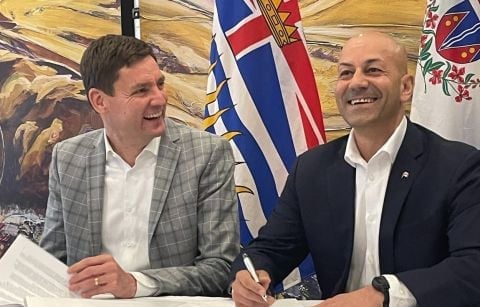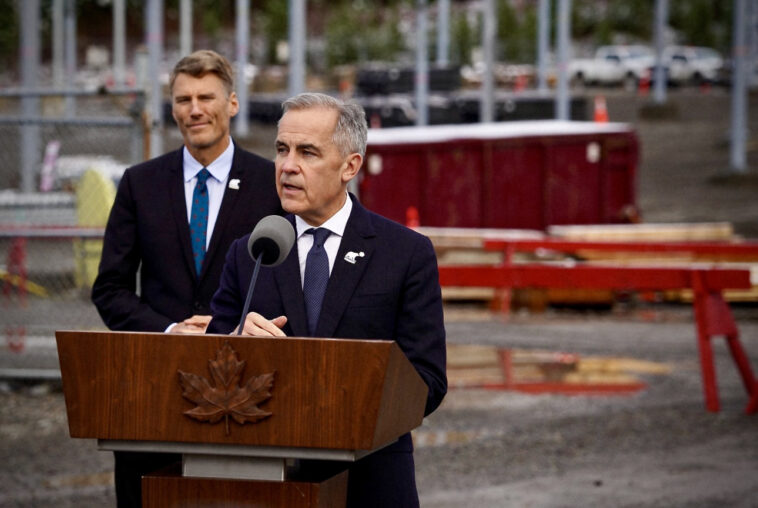By Rochelle Baker, Local Journalism Initiative, Canada’s National Observer
Prime Minister Mark Carney announced the addition of the North Coast Transmission Line (NCTL) to his list of projects of national importance on Thursday.
The $6-billion transmission line in northern BC will now be fast-tracked by the Major Projects Office, developed by the federal government to speed proposals expected to boost Canada’s economy and lessen trade dependence with the United States and the impact of US President Donald Trump’s tariff regime.
“Clean electrification is the path — the only path — to building a sustainable, prosperous economy.”
Prime Minister Mark Carney
The transmission line is part of a larger strategy to take advantage of and expand the country’s clean electricity grid and ensure Canada benefits from its enormous gas and critical mineral reserves, Carney said.
“Clean electrification is the path — the only path — to building a sustainable, prosperous economy,” he said.
The Canada Infrastructure Bank (CIB) is providing a $140 million loan to fund early work on the transmission line to BC Hydro, Carney added.
The NCTL also features in the development of another new major project: a proposed northwest critical conservation corridor across northern BC and the Yukon meant to open access to the critical minerals in the region, while also creating a conservation area the size of Greece, the prime minister said.
As part of the corridor proposal, the government will aim to build new transmission lines, upgrade highways, install fibre and cell towers and invest in communities in the region while encouraging “meaningful Indigenous ownership” and “promoting the conservation of our natural heritage for future generations,” Carney said. Carney also announced five other projects, including the proposed Ksi Lisims LNG export project slated for BC’s north coast near Prince Rupert.
The other projects include:
- The Iqaluit Nukkiksautiit hydroelectric project;
- The Nouveau Monde Graphite Phase 2 project in Quebec;
- The Sisson Mine, for critical minerals, in New Brunswick; and
- The Crawford Nickel project in Ontario.
The North Coast Transmission Line (NCTL), expected to take between eight and 10 years to construct, will power liquefied natural gas (LNG) export facilities, mining and natural gas production, as well as Prince Rupert port expansions.
It will double the electricity flowing from Prince George to Terrace and, at a later stage, northward to Bob Quinn Lake. The BC government has been pushing for federal funding for the project and for it to make Carney’s major projects list.
Transmission line powers multiple ambitions

The NCTL is the backbone for provincial and federal ambitions to expand and secure LNG export projects on the West Coast and to provide the power needed to attract mining investment to the northern reaches of BC.
Its supporters argue it will provide clean electricity to power those industries and natural gas production and transport to reduce the burning of fossil fuels and curb the resulting carbon pollution.
The NCTL plans also include a potential substation expansion and spur line to serve the Port of Prince Rupert and expand the nearby Ridley Island export terminal, now dubbed the Ridley Island Energy Export Facility (REEF), to boost the export of propane, butane and possibly ethane to Asian markets.
The third phase of the transmission line project spans Terrace north to Bob Quinn Lake and is still in early development. It is key to a proposal to link the power grids of BC and Yukon.
The two governments signed a memorandum of understanding in May intended to drive economic development and increase the flow of clean energy to the territory, which still leans on fossil fuels for electricity, especially in remote areas.

Carney’s first round of major projects announced in September included two other resource projects in BC long in development: the Red Chris copper and gold mine and Phase 2 of the existing LNG Canada project in Kitimat, expected to double the plant’s output.
Neither LNG Canada Phase 2 nor Ksi Lisims has secured a final investment decision, but the transmission line is expected to sweeten the deal and attract the needed capital.
Ksi Lisims is required by the province to use clean electricity to operate, but LNG Canada’s second phase was previously approved to operate gas turbines at the plant. Shell, the lead company partnered in the project, has said it would transition to electricity once it’s available.
The BC government has already taken steps to fast-track the power project, including bypassing a review by the province’s independent regulator, the BC Utilities Commission, to stave off a possible 18-month delay to construction. However, the push by the province is raising questions of transparency, cost allocation and risk to ratepayers.
The project has also been exempted from an environmental review, a move drawing heavy criticism from conservation groups and First Nations concerned about the lack of consultation and potential environmental impacts of the project.
Eby has also declared the project is non-negotiable, declaring he’s prepared to call an early election if Bill 31 tied to the NCTL isn’t passed. The legislation will allow the province to prioritize the projects that get power and offer a pathway for First Nations to invest in co-ownership in the transmission line.
Grid ‘greenwashes’ LNG, say critics

Using clean power to produce LNG won’t protect Canada from climate impacts when it’s burned overseas, said Marc Lee, senior economist with the Canadian Centre of Policy Alternatives.
Despite the transmission line’s potential economic benefits for First Nations and mining expansion in the North to diversify exports, there’s a real risk that the provincial and federal government’s LNG ambitions won’t be realized, leaving the province with stranded assets and a surplus of energy without enough customers to pay for it, Lee said.
“Our politicians are all racing to get this stuff built to show that they’re doing stuff for the economy, but it may just be a complete white elephant.”
Marc Lee, Senior Economist at the Canadian Centre of Policy Alternatives
It’s mostly LNG demand that’s driving the NCTL, Lee said. Yet, there are numerous predictions that there will be a decline in demand in the coming decade.
“Our politicians are all racing to get this stuff built to show that they’re doing stuff for the economy, but it may just be a complete white elephant.”
Carney suggested otherwise on Thursday, claiming that by 2040, global LNG demand is expected to rise by 60 per cent and “Canada will be ready.”
The NCTL line does open up opportunities for port electrification, mining and economic development in northern BC and potentially the Yukon and the benefit of construction jobs in various regions where it will be built, said Werner Antweiler, a Sauder School of Business professor at the University of British Columbia.
Given that a number of LNG projects are set to come online, the project offers the potential for significantly reduced emissions.
“I think the benefit to the BC economy is pretty clear,” Antweiler said, but “the billion-dollar question” is who will pay for it.
“It’s going to be spread over all rate payers like you and me and the small businesses and office buildings down the street.”
Marc Lee, Senior Economist at the Canadian Centre of Policy Alternatives
The province needs to be transparent about its new tariff scheme and set a rate structure to “recover the cost from project proponents.”
Lee isn’t optimistic that will happen.
“It’s going to be spread over all rate payers like you and me and the small businesses and office buildings down the street,” he said.




